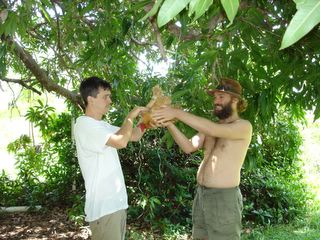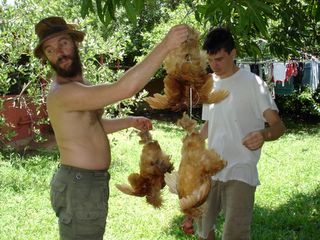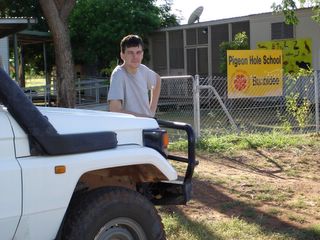Monday, Feb. 14: When we arrive at Pearl’s house, she immediately asks for her travel allowance so she can give her daughter (staying at the house) money for a power card (for electricity). I go to the back of the Troopie to start moving things around so we can fit people in the back (we know some people will be getting a lift with us). Before I can do anything, a 10-year-old child of indeterminate sex comes up and thrusts a tiny baby at me and says something like, “Hold ‘im for mum.”
“Oh, I need to move things around back here,” I say, but the child insists on putting the baby in my arms and says, “I can move stuff.”
I stand there kind of dumbly for a moment, not able to explain where I want stuff and then realize that I am holding a newborn baby in the sun. I retreat to the shade of the porch, watching as a number of small children swarm the back of the Troopie.
At some point Justin asks Pearl who all is going with us to which she replies, “Only my granddaughter and her husband.” Eventually, after lots of time and not a lot of communication, we get settled in. Turns out Pearl was only counting adults. Pearl sits in the front passenger seat and I am joined in the back by granddaughter and her husband (both look to be in early-mid twenties), their newborn baby (who I later find out is two weeks old), a child of about 2, a child of about 4, the 10-year-old, and a girl with ferociously plucked eyebrows of about 13 or so. I’m not sure anybody’s relationship or even the sex of the children. I find out later that all but the baby are girls, that only the three youngest belong to the couple, and that the ten-year-old is the sister of the husband. I never find out who the plucked eyebrow girl is (direct questions here, as in so much of the world, are seen as rude), but she rides back with us to Katherine when we leave Pigeon Hole a few days later.
It is impossible to keep suggesting that everyone should be seatbelted in, even if legally Justin, as the driver, is responsible. I give up on worrying about it for the most part, although everyone makes a show of buckling the kids up at the start of each leg of the journey. The baby is passed around on a bed pillow. I take a couple turns holding him. He mostly sleeps. His nappy seems to be a washcloth or hand towel (terry cloth) and pinned with one pin in front. I seem to remember from my baby-sitting days that we pinned diapers with two pins, one on each hip. I remember there being a very specific and elaborate way of folding diapers, too, and I suddenly realize that that was probably fairly arbitrary and not a universal solution to the problem. This single-pin towel method seems to work fine.
From Pearl’s house we make several errand stops, the last one being at a gas-station on the way out of town, where the family gets a bunch of fried chicken and chips (French fries), bags of potato chips or some other cold crunchy snacky, a bag of some kind of chewy sticky candy that later turns up stuck to seatbelts and luggage, a couple loaves of bread, some bottles of juice-drink. I hold the baby-on-pillow while everybody eats chicken.
At Top Springs (about 2/3rds of the way, I think), we stop. It seems to consist solely of this roadhouse, as there’s no sign of an actual community or town. The woman working there is planning a trip to Canada soon with her friend. They’re going to stay for at least a year. They also want to go to Cuba. The only places they really want to go in the US are Las Vegas and New Orleans. She remarks on my being so white when I’m from California (as if I should necessarily have a dark tan).
As we leave Top Springs there are a lot of flies in the back, attracted by their fried chicken remains which they eat on some more now. The parents have also bought a bag of ice which they add to their plastic water bottles and also hand out to the kids as snacks. At this point the parents start pointing stuff out to me in the landscape, stuff that I can’t see or can’t understand, but it’s clearly about locations—not “see that bird” so much, though there might have been a few of those—things like “Such-&-such is thataway” and “such-&-such is over there behind such-&-such”. I understand that sometimes they’re telling me about stations (cattle ranches), and at one point they tell me about a nice spring.
Arrive at Pigeon Hole
Pearl directs us to drive between the houses into a sort of backyard area where people are hanging out outside on a mattress and blankets under a tree. There is trash blown about right around the houses and around where people are hanging out. There is no sense of the orderliness that marked most rural Solomons villages, with their delineated walks and plantings and rubbish piles and I am reminded that these were nomadic people until recently, who lived in this amazing environment without building permanent shelters.
We meet the new teacher, a Canadian, on her first teaching assignment, who is teaching the upper primary (grades 3-7) and the principal/lower-primary teacher who is actually from Pigeon Hole, but has lived other places as well. Both are really nice and motivated teachers and it’s good to spend some time talking to each of them.
Justin and I go for a walk that first night on the airstrip, just after sunset. It’s lovely: wide open country, big skies.
Tuesday, Feb 16: I begin feeling sick early in the morning before getting up. Turns out to be diarrhea and I use up all the toilet paper in the girls’ bathroom. At one point I actually soil my pants (shades of our time in Eritrea). Fortunately I am wearing a menstrual pad. Unfortunately it’s not a disposable one, but a nice flannel one. Fortunately, I am feeling better by afternoon.
We play with kids in the playground during their breaks. The little kids are just amazingly affectionate, want to hug me a lot or be picked up, not in a needy way but in the way of kids who are used to getting and giving a lot of affection and I suppose just interested in novel experiences. I would pick one child up, have everyone count to five, then put that child down and pick the next one up. They are totally fine with that and did not argue about whose turn was next. I saw no pouting or tantrums at any point.
In the late afternoon, Justin and I are joined on a walk by several little kids (age 3-7). They hold our hands and each other’s hands and one says, “I like you” and I say back, “I like you, too.”
Then another says, “I like you” and I say “I like you too” and so on with me and Justin and all of the kids.
I try summarizing with “I like all of you” but they don’t get bored with the basic routine at all. After a bit of silence or maybe some talk about something else, it starts again: “I like you” etc.
Pretty cute!
Wednesday, Feb 16: We take the lower primary class (not counting the pre-school kids) out in the Troopie to look for bush tucker (wild food). I sit in the back with 7 kids aged about 5 to 7 years old. Justin, directed by the principal, drives out into the bush and we pile out of the car and follow her lead out among the bushes and trees.
I am really impressed with the kids. The kids are really cooperative with each other. Even though there isn’t much fruit on the bushes, they share with each other, especially after the teacher says mildly, “Make sure everyone gets some.” They don’t complain about being hot, their feet hurting (they are mostly barefoot), the road being bumpy, etc. I don’t think I ever heard them complain. Not sure about that. General impression though was that they were happy to follow along after their teacher then spread out around a bush. They’d venture a little way off, but not so far as to make even me nervous. They were just generally agreeable and confident and happy.
Pearl and Justin do a lesson with the bigger kids after we get back from our bush trip. At first it seemed impossible to get them to settle down, but eventually they got interested in Pearl’s stories and started asking her questions about Dreaming stories and the past history of Pigeon Hole.
Our
return trip
on Thursday was relatively uneventful.






















